INTRODUCTION
Generally about this work package
The GEOCAP work package “Drilling skills” focussed on A) corrosion problems B) a study on gas lift in production wells re-using gas from the reservoir and C) using slim hole drilling techniques. Several items for this work package are worked out by ITB and IF Technology.
- A) Corrosion has a major impact on geothermal wells. For many projects, this is one of the main risks with a high impact on the exploitation. Highly corrosive liquids/steam produced do have a big impact on the integrity of the wells and surface installation. ITB worked on this subject and delivered several related articles. These can be found on the GEOCAP website.
- B) IF Technology did specific research on a new technique to re-use out coming gases from produced reservoir water for gas lifting geothermal wells using a closed loop system. This specific research can also be found on the GEOCAP website (Artificial Lift in Geothermal Wells: A Study to Binary Cycle Geothermal Power Plants with Gas Lift in the Production well; F.W.J. Niewold, GEOCAP/2017/REP/IF Technology/WP2.03)
- C) Furthermore research has been done on the use of slim hole drilling techniques for drilling geothermal wells. ITB worked out some articles on this item (see GEOCAP website). IF Technology looked into the feasibility of using slim hole drilling techniques for small scale and less deep (in sedimentary basins) geothermal projects.
For this handbook, the latter item is worked out more in specific. However, the reader of this handbook-item is advised to have a more detailed look on the GEOCAP website for the other interesting articles and reports that have been made for this work package.
Small-scale direct use of geothermal energy in sedimentary basins using slimhole drilling techniques
The focus of Indonesian geothermal market is exploiting big geothermal fields in high enthalpy volcanic systems. However many remote areas in Indonesia are less populated, less accessible and less developed. Expensive and complicated deep and high enthalpy projects will not easily be developed in these areas.
Therefore, it can be interesting to focus on less deep and smaller geothermal energy systems. Making smaller projects using slim holes (small hole drillings) into shallow sedimentary layers could improve business cases: less investment costs, less environmental impact, less project development time, better match between heat-demand and heat delivery and less drilling risks. Small-scale projects could finally lead to more projects, as these are easier to finance and develop. Many small geothermal projects could lead to a significant contribution of the environmental objectives to reduce CO2 emissions.
In this research, we investigated the direct-use of geothermal heat in industry using slimholes in sedimentary basins as competitive alternative to conventional sources of energy.
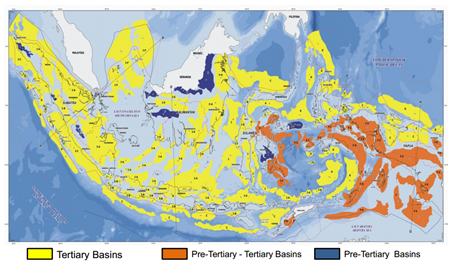
Figure 44 Sedimentary basins in Indonesia (Source: Badan Geologi KESDM)
RELEVANCE FOR AND APPLICABILITY TO INDONESIA
Indonesia has one of the largest geothermal potentials of all countries in the world. In Indonesia, geothermal energy is synonymous with power generation from high enthalpy volcanic systems. These volcanic systems are commonly found in mountainous and therefore quite sparsely populated areas, while industrial centres are concentrated in the lowlands where there is lots of people and good transport infrastructure.
This does not mean that the idea is of using geothermal heat for industry in Indonesia is without merit. It does however require a different approach to geothermal than the prevailing notion that geothermal is only viable in high enthalpy volcanic systems. It is here that some of the experiences of using geothermal heat from sedimentary geology could be of use. Using direct geothermal heat from sedimentary basins is developing fast in parts of Europe.
The downside of sedimentary geology compared to volcanic regions is that the geothermal gradient is generally lower. This means that much deeper and therefore more expensive wells are required to achieve the same production temperature. The upside is that the permeability of sedimentary layers is more uniform, reducing the drilling risks and the need for extensive exploration efforts. On top of that, many sedimentary basins have been subjected to oil and gas exploration further reducing the need for additional surveys and exploration wells.
As there is no conversion efficiency in a direct-use application the potential thermal power output of a well is generally significantly higher than the electrical power output. The downside of a direct-use well is that thermal energy is much harder and therefore more expensive to transport than electrical energy. This means that the energy must be used locally putting a restriction on how much offtake you can realize.
As an example, a conventional geothermal well in a sedimentary basin: It could easily produce a flow of 250 m3/hour. If this flow were cooled down by 50°C, the thermal output of the well would be about 20MW. The demand of the local industry however is in almost all cases lower than 20MW. This leaves two options, pooling multiple users together or developing smaller wells (also called slim-hole wells). The challenge with pooling different users is that it becomes much more complex from an organizational perspective. All parties have to agree on the set-up and operation of the project. It is therefore worthwhile to look at the option of using smaller and cheaper wells to provide a suitable power output for a single user.
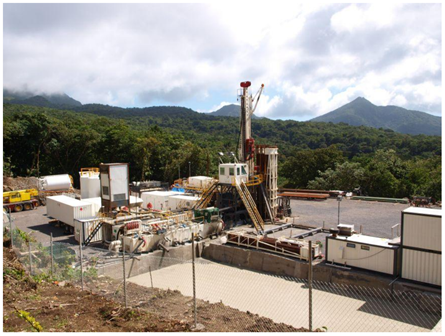
Figure 45 Rotary rig drilling slim holes up to 1500m (Source: ISOR)
Slimhole drilling
Making these small-scale geothermal direct-use projects feasible requires the smaller wells to also be cheaper compared to conventional geothermal production wells. Slim hole wells are already applied in oil and gas industry as well as in mining and geothermal exploration. As far as we know slim hole wells have not (or only scarcely) been used as direct heat supply for industry or other applications.
Sedimentary basins
Most of the Indonesian industry is situated nearby the major cities in industrial estates. Most of these Industrial estates are located in the sedimentary basins. Therefore, we focussed on sedimentary basins in this study.
GEOCAP ACTIVITY IN THIS TOPIC
Set-up of the research
First a literature review about the state of art of slim hole drilling worldwide and especially in Indonesia was performed. Market opportunities within the Indonesian Industry have been evaluated. Based on this information a well design for a specific case was made and a business case was developed to verify the economic feasibility.
The most and biggest cities are located at Java, the relative potential can be found there. Besides this, the most information of the geology (temperatures, depths and Aquifer thickness) is available from Java within the GEOCAP project (WP 3.0). This is the main reason this study focussed on two industrial Estates located near Jakarta. These Industrial Estates are situated in the Northwest Java Basin. These industrial Estates are Jababeka and Karawang.
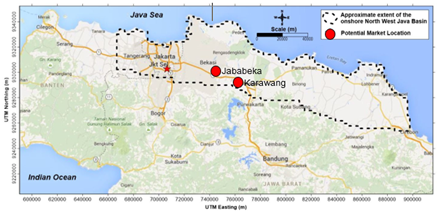
Figure 46 Location of Jababeka and Karawang
Temperatures and depth
In the Jakarta area, in the Northwest Java Basin, two major Aquifers are situated, the Baturaja Aquifer and the Talang Akar Aquifer. The temperatures and depths of several wells in this area have been mapped. From this data, it is found that the most potential aquifers are found at circa 2500m depth and the reservoir temperatures are around 120 degrees Celsius.
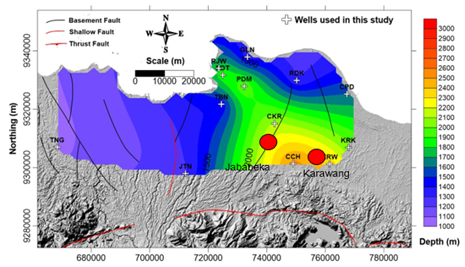
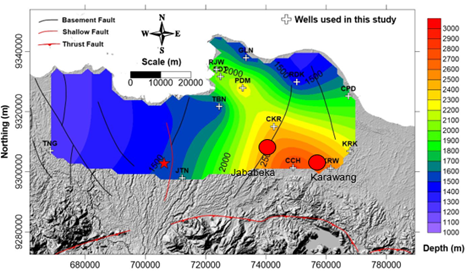
Figure 47 Mapping of the distribution of depth to the centre of Baturaja aquifer (above) and Talang Akar aquifer (below)
Evaluation of market opportunities
This study focused on present Industry in Karawang and Jababeka. The following users in the industrial areas of Karawang and Jababeka are seen as practical potential users of direct use of geothermal energy:
- Paper Industry
- Processing of Palm oil (Indonesia is the biggest supplier of palm oil in the World)
- Milk Industry Food industry
- Consumer goods
The energy demands vary between the several potential users. An estimation of the thermal energy demands has been made and is expected to be between 3 – 10 MW thermal energy. The required temperatures has been determined between 55 – 135°C.
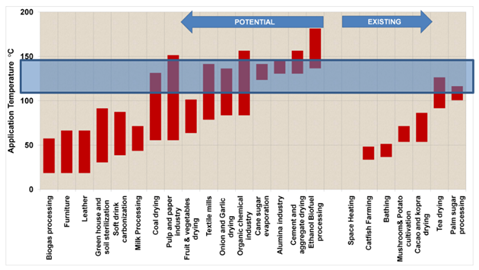
Figure 48 Potential consumers of geothermal direct heat
Business case excel tool
For this specific case a slimhole design was made and the business case was calculated using a new developed excel tool. This tool is available on the GEOCAP website.
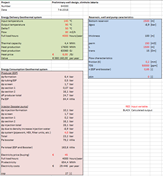
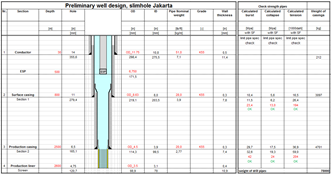
Figure 49 Typical input and outcome of the excel tool
Conclusions
- Slim holes can supply industrial users with sustainable heat.
- In case of hot water production for single industrial users, a payback period is estimated at 9 years. The investment required is estimated at 6 M$.
- Compared to standard (large scale) geothermal wells, small projects using slim holes will be much easier to realize, due to
- much lower investments
- small projects are easier to organize (only one user/heat-consumer required)
- due to a better match with the local demands, it fits for purpose and therefore it can be used more widely.
- the impact of several risks are limited
- space requirements are limited
MAterials
CONTACT
Bas Pittens (IF Technology)

